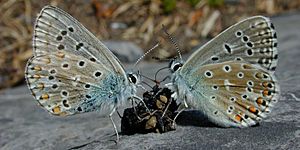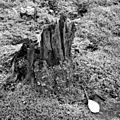Detritivore facts for kids

Detritivores are living things that get their food by eating detritus. Detritus is made of dead plant and animal parts, and also animal waste (like feces). Think of them as nature's clean-up crew!
Many different creatures are detritivores. These include invertebrates (animals without backbones), vertebrates (animals with backbones), and even some plants. By eating detritus, they help with decomposition (breaking things down) and nutrient cycles. This means they help put important nutrients back into the soil.
It's important to know that detritivores are different from other decomposers. Decomposers like bacteria, fungi, and protists are too small to eat big pieces of stuff. Instead, they absorb nutrients at a tiny, molecular level. Detritivores, on the other hand, usually eat chunks of matter.
Detritivores are often arthropods (like insects and spiders). They start the process of putting minerals back into the environment. They break down dead plant matter into smaller pieces. This makes it easier for other decomposers to finish the job.
Plant parts are made of tough stuff like cellulose and lignin. These break down slowly. Detritivores are why we don't see huge piles of dead leaves and plants everywhere in nature. They help keep our planet tidy!

Detritivores are very important in all ecosystems. An ecosystem is a community of living things and their environment. Detritivores can live in any soil that has organic material. This includes ocean ecosystems, where they are often called bottom feeders.
Some common detritivore animals are millipedes, springtails, woodlice, dung flies, slugs, many worms, sea stars, sea cucumbers, fiddler crabs, and some types of marine worms.
We can group detritivores by their size. Macrodetritivores are larger, like millipedes and woodlice. Microdetritivores are tiny, like bacteria.
Scavengers are not usually called detritivores. Scavengers eat large amounts of dead animals. But both detritivores and scavengers are types of consumers that eat dead organic matter. Eating dead wood is called xylophagy. Animals that only eat dead wood are called sapro-xylophagous.
How Detritivores Help Ecosystems
Detritivores are super important recyclers in an ecosystem. They help with the flow of energy and the cycling of nutrients. They are especially good at returning nutrients to the soil.
Detritivores and decomposers put important elements back into the soil. These elements include carbon, nitrogen, phosphorus, calcium, and potassium. Plants then use these elements to grow. Detritivores shred dead plant matter. This releases the nutrients trapped inside the plants. When there are many detritivores in the soil, nutrients are recycled very well.
Rainfall affects how detritivores eat. Wet soil makes detritivores eat and excrete more.
Many detritivores live in old woodlands. But they also live in wet places, like the bottom of oceans. These creatures are key in benthic (bottom) ecosystems. They form important food chains and help with the nitrogen cycle.
Detritivores and decomposers in deserts live underground in burrows. This helps them avoid the hot surface. Underground, conditions are better for them. Detritivores are the main organisms that clear plant litter and recycle nutrients in the desert. Because there isn't much plant life in deserts, desert detritivores have found ways to eat in these tough conditions.
Fungi are important decomposers in land environments today. Long ago, during the Carboniferous period, fungi and bacteria could not digest a tough substance called lignin (found in wood). Because of this, huge amounts of dead plant material built up. This material later became the fossil fuels we use today.
Images for kids
-
Fungi are key decomposers in most places, like this Mycena interrupta. Only fungi can break down lignin, which is a complex substance in wood.
-
A decaying tree trunk in Canada's boreal forest. Decaying wood is important for nature. It provides homes and shelter, and returns nutrients to the soil.
See also
 In Spanish: Detritívoro para niños
In Spanish: Detritívoro para niños




